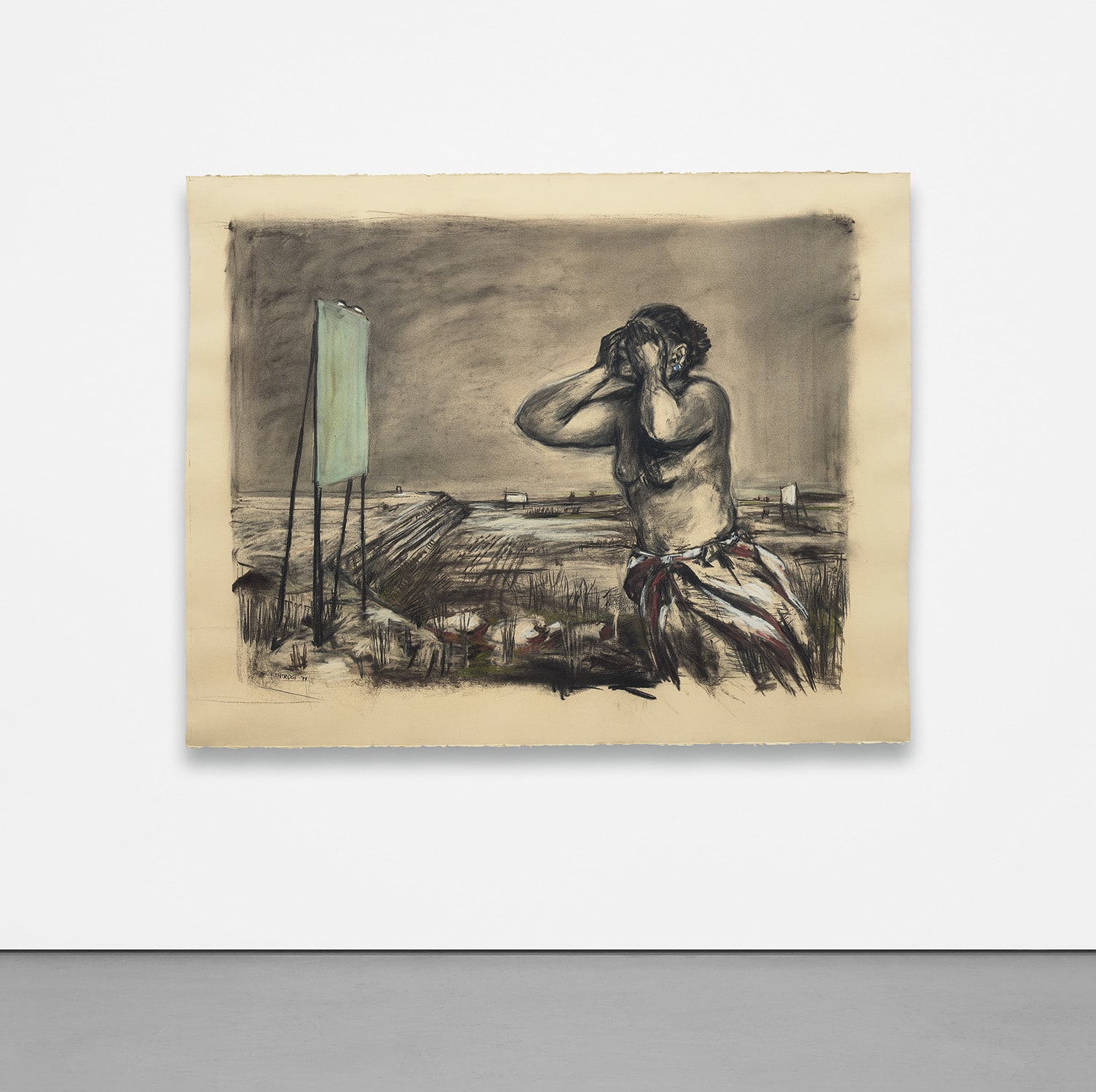



21
William Kentridge
Drawing for Felix in Exile (Nandi's Cry)
signed and dated 'KENTRIDGE '93' lower left
charcoal and pastel on paper
108 x 136 cm (42 1/2 x 53 1/2 in.)
Executed in 1993.
Full-Cataloguing
Covering a wide breadth of genres – animation, drawing, collage, performance – William Kentridge’s creations come close to what German opera-composer Richard Wagner named the ‘Gesamtkunstwerk’: the synthesis of various or all art forms. Known for his complex drawing method consisting of laying bare erasures, smudges and altered forms, as well as exposing a sketch’s multiple compositional recesses, the artist has built an oeuvre that defies categorisation, distinctly tied to draughtmanship whilst simultaneously living on the cusp of cinematic dynamism. It is thus unsurprising that a large part of his work would be dedicated to film; in the present work, Drawing for Felix in Exile (Nandi's Cry), 1993, the artist has alluded to both static and moving media, utilising the central image from an animation picture he was concurrently working on from September 1993 to February 1994, entitled Felix in Exile – today residing in such eminent institutions as the Tate Collection, London, the Museum of Modern Art, New York, and the Guggenheim, New York. Although the present work was not used as a working animation sequence in Felix in Exile, it provides a compelling peek into the film’s narrative, which conveys themes of memory and loss within a geo-political landscape.
Felix in Exile was the fifth of nine films Kentridge completed in his Drawings for Projection, conceived between 1989 and 1999. Within the series, each sequence from each film had been altered and photographed in 16 or 35mm film, remnants of successive stages later remaining on paper as independent drawings. In Felix in Exile, the character of Nandi was introduced for the first time; she initially appears mapping the history of the terrain surrounding her – Johannesburg’s East Rand, where dilapidated mines and factories have created a landscape of nostalgia and loss. She is presented as a documentor, a surveyor, a presence to record events in a world otherwise silent. Notably, Felix in Exile was conceived amidst ongoing public debates on the relationship between the country’s division of ownership and the formation of identity which accompanied the first open elections in South Africa. The present work thus tells a story of identity, hopes and fears for a new future. In it, the titular protagonist has concealed her eyes with her hands, in an act that seems desperate or ‘brought about by the process of painful remembering’ (Elizabeth Manchester, ‘Felix in Exile’, Tate, February 2000, online). She summons fraught notions of memory and collective identity, further vivified by Kentridge’s gestural marks, shadows and smudges. The temporal traces of his hand emulate a danse macabre of absence and presence, foreshadowing the protagonist’s death in successive stages of the film. Nandi is thus a critical drawing where form exquisitely meets meaning, encapsulating the talent with which Kentridge creates all-consuming narratives.
Felix in Exile was the fifth of nine films Kentridge completed in his Drawings for Projection, conceived between 1989 and 1999. Within the series, each sequence from each film had been altered and photographed in 16 or 35mm film, remnants of successive stages later remaining on paper as independent drawings. In Felix in Exile, the character of Nandi was introduced for the first time; she initially appears mapping the history of the terrain surrounding her – Johannesburg’s East Rand, where dilapidated mines and factories have created a landscape of nostalgia and loss. She is presented as a documentor, a surveyor, a presence to record events in a world otherwise silent. Notably, Felix in Exile was conceived amidst ongoing public debates on the relationship between the country’s division of ownership and the formation of identity which accompanied the first open elections in South Africa. The present work thus tells a story of identity, hopes and fears for a new future. In it, the titular protagonist has concealed her eyes with her hands, in an act that seems desperate or ‘brought about by the process of painful remembering’ (Elizabeth Manchester, ‘Felix in Exile’, Tate, February 2000, online). She summons fraught notions of memory and collective identity, further vivified by Kentridge’s gestural marks, shadows and smudges. The temporal traces of his hand emulate a danse macabre of absence and presence, foreshadowing the protagonist’s death in successive stages of the film. Nandi is thus a critical drawing where form exquisitely meets meaning, encapsulating the talent with which Kentridge creates all-consuming narratives.